Chapter 6 Space Physics
6.1 Earth and the Solar System
CORE
1. Know that the Earth is a planet that rotates on its axis, which is tilted, once in approximately 24 hours, and use this to explain observations of the apparent daily motion of the Sun and the periodic cycle of day and night
2. Know that the Earth orbits the Sun once in approximately 365 days and use this to explain the periodic nature of the seasons
3. Know that it takes approximately one month for the Moon to orbit the Earth and use this to explain the periodic nature of the Moon’s cycle of phases
SUPPLEMENT
4. Define average orbital speed from the equation \(v = \frac{2\pi r}{T}\)
where r is the average radius of the orbit and T is the orbital period; recall and use this equation
• The Earth is a planet that rotates on its axis, which is an imaginary line that passes through the North and South poles. The axis is tilted at an angle of 23.5 degrees from the vertical. The Earth rotates from west to east, which means that the Sun and the Moon appear to rise in the east and set in the west. The
Earth takes about 24 hours to complete one rotation, which is why we have day and night.
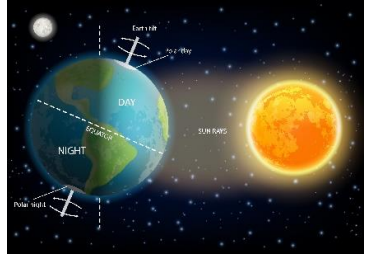
• The Earth also orbits around the Sun, which is a star that provides light and heat to our planet. The Earth’s orbit is not a perfect circle, but an ellipse, which means that sometimes the Earth is closer to the Sun and sometimes farther away. The Earth takes about 365 days to complete one orbit, which is why we have a year. The tilt of the Earth’s axis and its orbit around the Sun cause the seasons,
because different parts of the Earth receive different amounts of sunlight throughout the year.
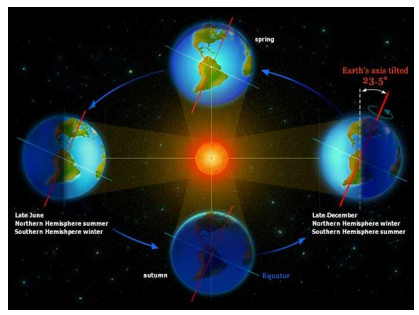
• The Moon is a natural satellite that orbits around the Earth. The Moon reflects the light from the Sun, which makes it visible in the night sky. The Moon takes about 28 days to complete one orbit, which is why we have a month. The shape of the Moon changes as it orbits around the Earth, because we see different parts of its illuminated side. These changes are called phases of the Moon.
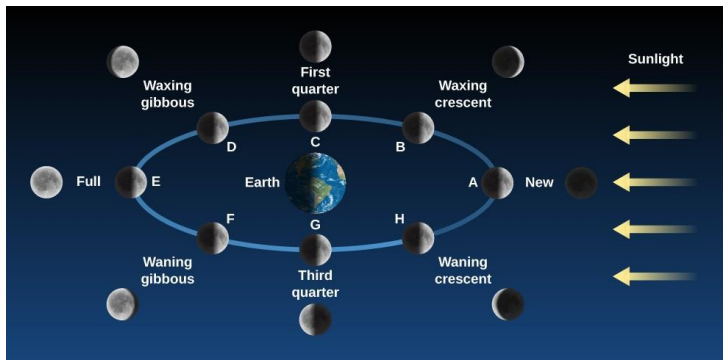
• The average orbital speed of an object is how fast it moves along its orbit. It depends on how far away it is from what it orbits and how long it takes to complete one orbit. We can calculate the average orbital speed using this formula:
\(v=\frac{2\pi r}{T}\)
where v is the average orbital speed, r is the average radius of the orbit, and T is the orbital period (the time for one orbit).
• For example, if we want to find out how fast the Earth moves around the Sun, we can use this formula:
v = 2π\(\frac{ (150 million km)}{(365 days)}\) = 29.8 km/s.
This means that the Earth travels about 30 km every second along its orbit around the Sun
6.1.2 The Solar System
CORE
1. Describe the Solar System as containing:
(a) one star, the Sun
(b) the eight named planets and know their order from the Sun
(c) minor planets that orbit the Sun, including dwarf planets such as Pluto and asteroids in the asteroid belt
(d) moons, that orbit the planets
(e) smaller Solar System bodies, including comets and natural satellites
2. Know that, in comparison to each other, the four planets nearest the Sun are rocky and small and the four planets furthest from the Sun are gaseous and large, and explain this difference by referring to an accretion model for Solar System formation, to include:
(a) the model’s dependence on gravity
(b) the presence of many elements in interstellar clouds of gas and dust
(c) the rotation of material in the cloud and the formation of an accretion disc
3. Know that the strength of the gravitational field (a) at the surface of a planet depends on the mass of the planet
(b) around a planet decreases as the distance from the planet increases
4. Calculate the time it takes light to travel a significant distance such as between objects in the Solar System
5. Know that the Sun contains most of the mass of the Solar System and this explains why the planets orbit the Sun
6. Know that the force that keeps an object in orbit around the Sun is the gravitational attraction of the Sun
SUPPLEMENT
7. Know that planets, minor planets and comets have elliptical orbits, and recall that the Sun is not at the centre of the elliptical orbit, except when the orbit is approximately circular
8. Analyse and interpret planetary data about orbital distance, orbital duration, density, surface temperature and uniform gravitational field strength at the planet’s surface
9. Know that the strength of the Sun’s gravitational field decreases and that the orbital speeds of the planets decrease as the distance from the Sun increases
10. Know that an object in an elliptical orbit travels faster when closer to the Sun and explain this using the conservation of energy.
• The Solar System is a collection of objects that orbit the Sun, which is the only star in our system and contains most of its mass.
• The eight planets are Mercury, Venus, Earth, Mars, Jupiter, Saturn, Uranus, and Neptune. They are divided into two groups: the inner rocky planets and the outer gas giants.
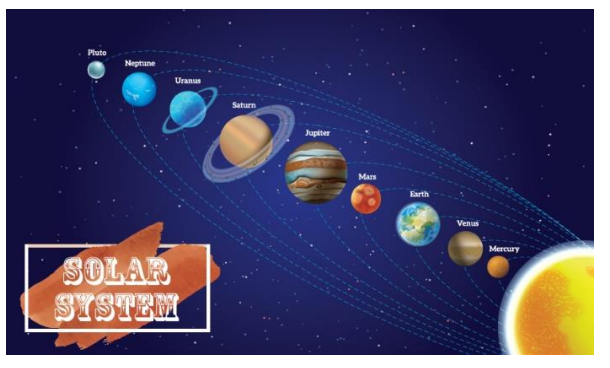
• There are also minor planets such as dwarf planets (e.g. Pluto) and asteroids, as well as moons that orbit the planets and smaller bodies such as comets and natural satellites.
• The Solar System was formed about 4.6 billion years ago from a cloud of gas and dust that collapsed and rotated to form an accretion disc. The Sun formed at the center and the planets formed from the remaining material.
• The planets have elliptical orbits around the Sun, which means they are not always at the same distance from it. The time it takes for a planet to complete one orbit is called its orbital period.
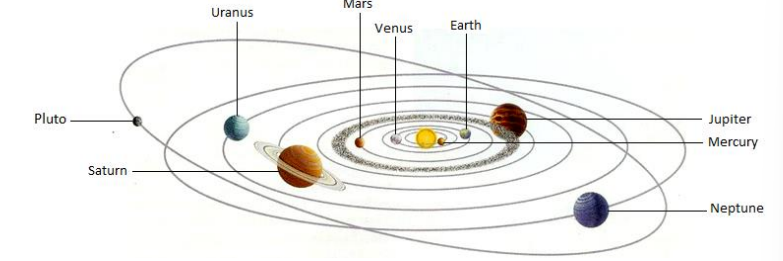
• The Sun emits electromagnetic radiation that travels through space at a constant speed of \(3.0 \times 10^8\) m/s. This radiation can be divided into different regions based on its wavelength and frequency, such as visible light, infrared, ultraviolet, X-rays, and gamma rays.
• The distance between objects in the Solar System is so large that it takes time for light to travel from one place to another. For example, it takes about 8 minutes for light to reach Earth from the Sun, and about 5 hours to reach Pluto.
• The gravitational force between two objects depends on their masses and their distance apart. This force keeps the planets in orbit around the Sun and also affects their shapes and motions.
• Some planets have rings made of dust and ice particles that orbit them. Saturn has the most spectacular rings in our Solar System.
• Some planets have natural satellites or moons that orbit them. Earth has one moon, while Jupiter has more than 70. Some moons have interesting features such as volcanoes, geysers, or oceans.
• The Sun has a very strong gravitational field that pulls the planets towards it. The closer a planet is to the Sun, the stronger the pull and the faster the planet orbits around it. The farther a planet is from the Sun, the weaker the pull and the slower the planet orbits around it.
• For example, Mercury is the closest planet to the Sun and it orbits at an average speed of 47 km/s. Neptune is the farthest planet from the Sun and it orbits at an average speed of 5 km/s.
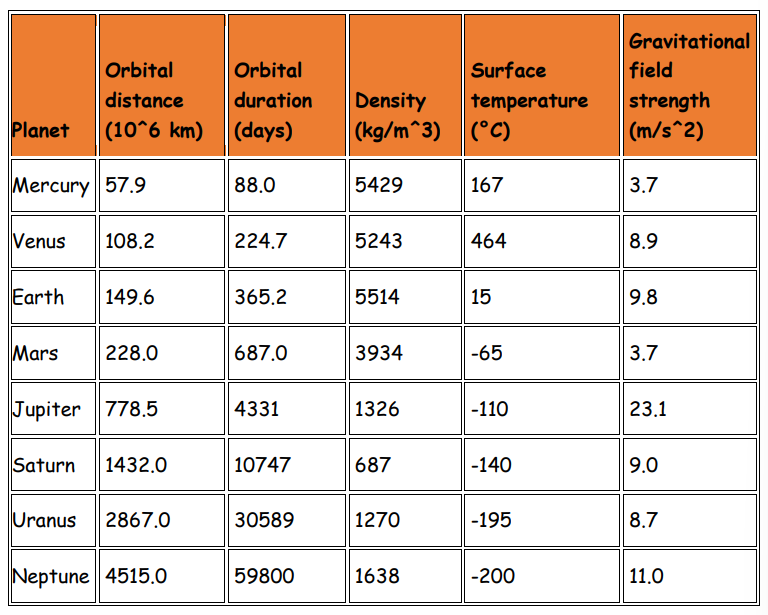
• The planets do not orbit in perfect circles, but in ellipses, which are like stretched circles.
• When a planet is closer to the Sun, it is at a point called perihelion. When a planet is farther from the Sun, it is at a point called aphelion. The distance between perihelion and aphelion is called eccentricity. The more eccentric an orbit is, the more oval-shaped it is.
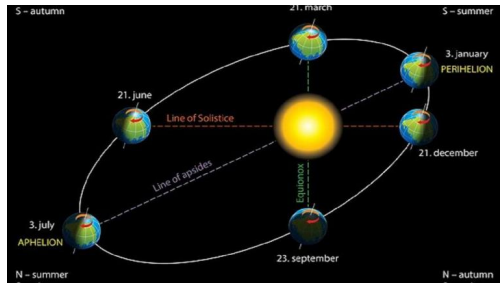
• For example, Mars has a more eccentric orbit than Earth, so its distance from the Sun varies more. At perihelion, Mars is 207 million km from the Sun. At aphelion, Mars is 249 million km from the Sun.
• When a planet is closer to the Sun, it has more kinetic energy (energy of motion) and less potential energy (energy of position). When a planet is farther from the Sun, it has less kinetic energy and more potential energy. The total energy of a planet in its orbit is always constant. This means that when a planet moves faster, it also moves closer to the Sun, and when it moves slower, it also moves farther from the Sun.
• This is an example of conservation of energy, which means that energy cannot be created or destroyed, but only changed from one form to another
6.2 Stars and the Universe
6.2.1 The Sun as a star
CORE
1. Know that the Sun is a star of medium size, consisting mostly of hydrogen and helium, and that it radiates most of its energy in the infrared, visible and ultraviolet regions of the electromagnetic spectrum
SUPPLEMENT
2. Know that stars are powered by nuclear reactions that release energy and that in stable stars the nuclear reactions involve the fusion of hydrogen into helium
• The Sun is a star of medium size that consists mostly of hydrogen and helium.
• The Sun releases most of its energy in the infrared, visible and ultraviolet regions of the electromagnetic spectrum. This energy comes from nuclear fusion of hydrogen nuclei into helium in the core of the Sun.
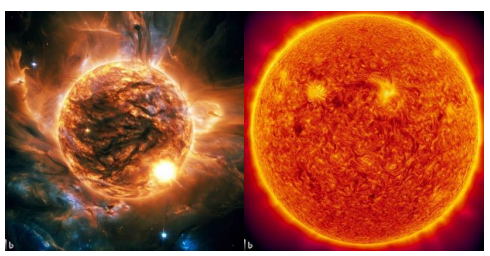
• Nuclear fusion is a reaction in which two or more atomic nuclei are combined to form one or more different atomic nuclei and subatomic particles. This releases or absorbs energy depending on the mass difference between the reactants and products.
• Nuclear fusion is the main source of energy for all stars, and it also produces most of the elements in the universe. The Sun fuses about 500 million metric tons of hydrogen each second.
• Nuclear fusion requires very high temperatures and pressures to overcome the repulsion between positively charged nuclei. The Sun’s core has a temperature of about 15 million kelvin and a density of about 150 times that of water.
6.2.2 Stars
CORE
1 State that:
(a) galaxies are each made up of many billions of stars
(b) the Sun is a star in the galaxy known as the Milky Way
(c) other stars that make up the Milky Way are much further away from the Earth than the Sun is from the Earth
(d) astronomical distances can be measured in light-years, where one light-year is the distance travelled in (the vacuum of) space by light in one year
SUPPLEMENT
2. Know that one light-year is equal to \(9.5 \times 10^{15}\) m
3. Describe the life cycle of a star:
(a) a star is formed from interstellar clouds of gas and dust that contain hydrogen
(b) a protostar is an interstellar cloud collapsing and increasing in temperature as a result of its internal gravitational attraction
(c) a protostar becomes a stable star when the inward force of gravitational attraction is balanced by an outward force due to the high temperature in the centre of the star
(d) all stars eventually run out of hydrogen as fuel for the nuclear reaction
(e) most stars expand to form red giants and more massive stars expand to form red supergiants when most of the hydrogen in the centre of the star has been converted to helium
• Galaxies are huge collections of stars, gas and dust that are held together by gravity. There are billions of galaxies in the universe, each with billions of stars. Our Sun is one of the stars in the Milky Way galaxy, which is shaped like a spiral.
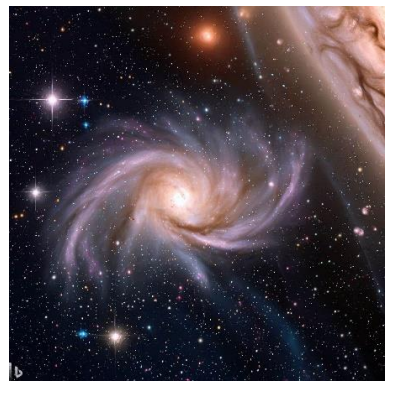
• The Sun is very far away from Earth, about 150 million kilometres. But other stars in the Milky Way are much further away, some as far as 100,000 light years. A light-year is the distance that light travels in one year, which is about 9.5 trillion kilometres. That’s a very long way!
• Stars are born from clouds of gas and dust in space, called nebulae
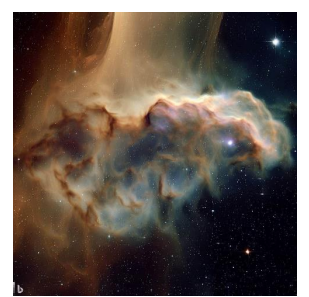
• Gravity makes these clouds collapse and heat up, forming protostars. When protostars get hot enough, they start to fuse hydrogen atoms into helium atoms, releasing energy. This is called nuclear fusion and it makes stars shine.
• A protostar becomes a stable star when the inward force of gravity is balanced by an outward force due to the high temperature in the centre of the star. This is called hydrostatic equilibrium and it lasts for most of the star’s life. The Sun is a stable star right now.
• Stars have different life cycles depending on their mass. Low-mass stars like our .Sun live longer than high-mass stars because they use up their fuel more slowly.
• When a star runs out of hydrogen in its core, it starts to fuse helium and other heavier elements. This makes the star expand and cool down, becoming a red giant or a red supergiant depending on its mass.
• A red giant from a low-mass star eventually sheds its outer layers, forming a planetary nebula with a white dwarf star at its centre. A white dwarf is very hot and dense, but it gradually cools down and fades away, becoming a black dwarf.
• A red supergiant from a high-mass star explodes as a supernova, forming a nebula containing hydrogen and new heavier elements. The supernova also leaves behind a very dense core that can become a neutron star or a black hole depending on its mass.
• The nebula from a supernova may form new stars with orbiting planets. This is how new generations of stars are born
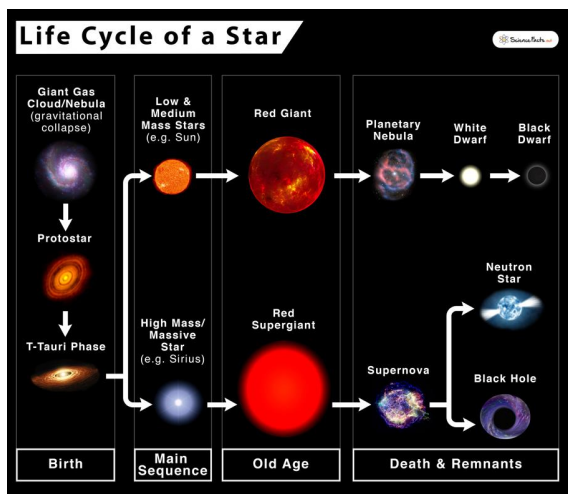
6.2.3 The universe
CORE
1. Know that the Milky Way is one of many billions of galaxies making up the Universe and that the diameter of the Milky Way is approximately 100 000 light-years
2. Describe redshift as an increase in the observed wavelength of electromagnetic radiation emitted from receding stars and galaxies
3. Know that the light emitted from distant galaxies appears redshifted in comparison with light emitted on the Earth
4. Know that redshift in the light from distant galaxies is evidence that the Universe is expanding and supports the Big Bang Theory
SUPPLEMENT
5. Know that microwave radiation of a specific frequency is observed at all points in space around us and is known as cosmic microwave background radiation (CMBR)
6. Explain that the CMBR was produced shortly after the Universe was formed and that this radiation has been expanded into the microwave region of the electromagnetic spectrum as the Universe expanded
7. Know that the speed v at which a galaxy is moving away from the Earth can be found from the change in wavelength of the galaxy’s starlight due to redshift
8. Know that the distance of a far galaxy d can be determined using the brightness of a supernova in that galaxy
9. Define the Hubble constant \(H_{0}\), as the ratio of the speed at which the galaxy is moving away from the Earth to its distance from the Earth; recall and use the equation
\(H_0 = \frac{v}{d}\)
10. Know that the current estimate for \(H_0\) is
\(2.2 × 10^{-18}\) per second
11. Know that the equation
\(\frac{d}{v} = \frac{1}{H_0}\)
represents an estimate for the age of the Universe and that this is evidence for the idea that all the matter in the Universe was present at a single point.
• The Milky Way is a huge collection of stars, gas and dust that forms a spiral shape. It is one of many billions of galaxies in the Universe. A galaxy is a group of stars that are held together by gravity. The diameter of the Milky Way is
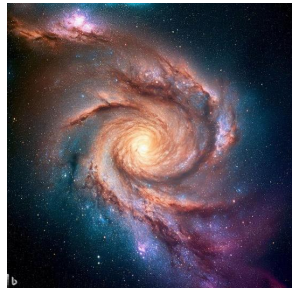
• Redshift is an effect that happens when light from a star or a galaxy is stretched as it moves away from us. This makes the light appear more red than it really is. The faster the star or galaxy is moving away, the more redshifted its light is. We can measure the amount of redshift by comparing the wavelengths of the light we receive with the wavelengths of the light we expect from the star or galaxy.
• Redshift in the light from distant galaxies is evidence that the Universe is expanding. This means that all the galaxies are moving away from each other and from us. The further away a galaxy is, the more redshifted its light is, and the faster it is moving away. This suggests that all the galaxies were closer together in the past, and that they started moving apart from a single point in space.
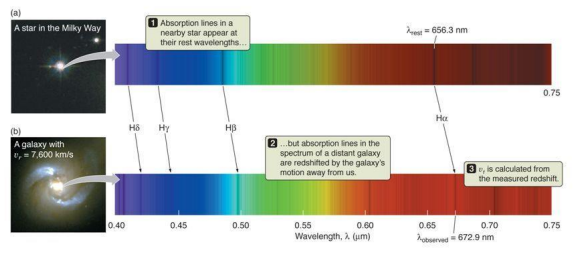
Redshift of a galaxy tells us its distance through HUBBLE’S LAW:
Distance = \(\frac{velocity}{H_0}\)
• The Big Bang Theory is a scientific model that explains how the Universe began and evolved. It says that about 13.8 billion years ago, all the matter and energy in the Universe was concentrated in a very small, hot and dense region. Then, a huge explosion happened, which started the expansion of the Universe. As the Universe expanded, it cooled down and formed stars, galaxies and other
structures.
• Cosmic Microwave Background Radiation (CMBR) is a type of electromagnetic radiation that fills all of space. It has a very low temperature of about -270°C.
It was produced shortly after the Big Bang, when the Universe was very hot and filled with radiation. As the Universe expanded, this radiation stretched and cooled down into microwaves. CMBR is evidence for the Big Bang Theory because it shows that the Universe was once much hotter and denser than it is now.
• The Hubble Constant (\(H_0\)) is a number that tells us how fast the Universe is expanding. It is equal to the ratio of the speed at which a galaxy is moving away from us to its distance from us. The current estimate for H0 is \(2.2 × 10^{–18}\) per second, which means that for every megaparsec (a unit of distance equal to 3.26 million light-years) a galaxy is away from us, it moves away at a speed of 2.2 km/s.
• The Hubble Constant can also be used to estimate the age of the Universe. If we assume that the Universe has been expanding at a constant rate since the Big Bang, then we can use this equation:
\(\frac{d}{v} = \frac{1}{H}\)
where d is the distance of a far galaxy, v is its speed away from us, and \(H_0\) is the Hubble Constant. This equation gives us an estimate for how long it took for that galaxy to reach its current distance from us, which is also an estimate for how long ago the Big Bang happened. This estimate is about 14 billion years, which agrees with other evidence for the age of the Universe.